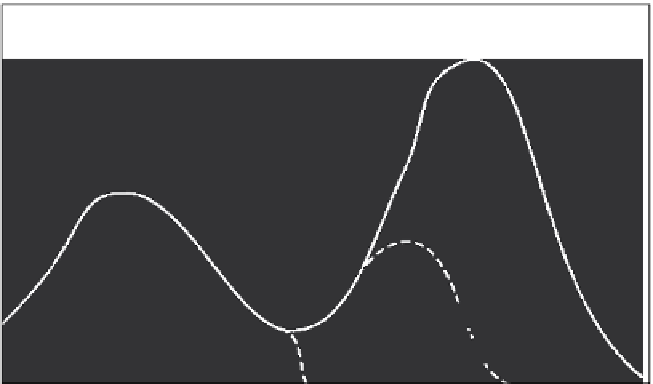Environmental Engineering Reference
In-Depth Information
23.2.2 i
ndoor
a
erosol
(t
able
23.1
and
F
igure
23.3)
Depending on the characteristics of a given structure and the mode of ventilation, the outdoor
aerosol can be an important contributor to the indoor aerosol. Indoor penetration of ine and
coarse ambient particulate has been estimated to be close to one [10]. Source apportionment
studies have indicated that the contribution of outdoor PM to the total indoor aerosol ranges
from 60% or more for PM ≤1 μm and declines with increasing PM to about 20% for PM between
6 and 10 μm [10,11]. Estimates based on studies in the eastern United States indicate that 75%
of the ine indoor aerosol during summer months is derived from the outdoors [12]. In contrast,
studies carried out in the western United States indicate a much lower penetration of ine PM
(∼27% for sulfate and 12% for PM
2.5
[13]). In addition, chamber studies indicate that ozone,
which in most residences has no indoor sources, can react with volatile organic compounds in
indoor environments to produce ine particulates (<0.5 μm) that are not generated originally in
the outdoor environment [14].
In homes with smokers, cigarette smoke is, by far, the most important contributor to indoor
aerosols. Figure 23.4 shows the effect of the presence of a smoker in an indoor environment on the
concentration of PM in the air [15]. Nicotine is found primarily in the tar (particulate) fraction of
tobacco smoke [16,17] and indoor residential concentrations range from 2 to 14 μg/m
3
in homes with
a single smoker [17]. Concentrations over 1000 μg/m
3
have been recorded in vehicles with ventila-
tion systems turned off [16,17].
Cooking is an important source of indoor PM, which is often not considered in terms of poten-
tial contribution to the total indoor particle burden [18]. Frying or use of an oven transiently can
be the dominant source of indoor aerosol, and a single episode of cooking on a stove can lead to
70
60
Total
sampler
50
40
PM
10
sampler
30
20
Tobacco smoke
Wood smoke
Combustion organics
soot
Pollens
Dust
Lint
10
Spores
PM
2.5
0
0.1
0.2
0.5
1.0
2
5
10.0
20
50
100
Aerodynamic particle diameter (D
a
), (µm)
Coarse
fraction
(2.5-10 µm)
Fine fraction (<2.5 µm)
PM
10
fraction (0-10 µm)
FIGURE 23.3
Distribution of particle mean diameter by particle volume for typical indoor PM aerosol. (From
McDonald, B. and Ouyang, M., Air cleaning—Particles, in Spengler, J.D., Samet, J.M., and McCarthy, J.F.,
Eds.,
Indoor Air Quality Handbook
, McGraw-Hill, New York, pp. 9.1-9.28, 2000.)

















































































Search WWH ::

Custom Search